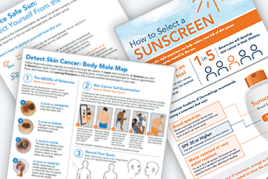Hives: Signs and symptoms
Swelling on your face, tongue, or throat?
Go to urgent care or your nearest emergency room. Swelling in any one of these areas can cause problems breathing or swallowing, which can come up quickly.

Common signs and symptoms of hives
This skin condition causes bumps and raised patches called hives. A single bump or patch is called a hive.
When you have hives on your skin, they can:
Itch, often intensely
Burn or sting
Feel warm to the touch
Where do hives develop on the body?
Hives can appear anywhere on your skin. Most people develop them on one or more of these areas:
Abdomen
Back
Buttocks
Chest
Upper arms
Upper legs
Some people also develop deep swelling called angioedema (an-jee-oh-uh-DEE-mah). This commonly develops on the face, especially the eyelids or lips. It can also affect the tongue, throat, arms, or legs.
What do hives look like?
This skin condition can appear on your skin in many ways, as the following pictures show. In the descriptions, you’ll find the signs and symptoms that hives can cause.
Raised spots, patches, or both
The rash of raised spots and patches may feel smooth. They can range in size from a pinhead to larger than a dinner plate and appear in different shapes.

Color varies with your skin tone
If you have brown or Black skin, hives are often the same color as your skin, or slightly darker or lighter than your natural skin tone. People who have a light or medium skin tone usually see red or pink hives. If you have a lot of swelling with a hive, you may see a hive that looks white in color.

Itchy rash that’s often warm
Hives can itch, sometimes intensely. Rather than itch, some people say the welts burn or sting. Because the skin is inflamed, hives often feel warm to the touch.

Hive blanches when you press on it
If you have hives, pressing down on one will make it turn pale or white, just as this woman’s finger lightens when pressed against glass. This color change is called blanching.

Appear suddenly and go away
Hives tend to appear suddenly and go away on their own. An individual hive will usually disappear within 24 hours, but new hives can appear. Most cases of hives go away within a few weeks, but some last longer.

Can develop in different areas or always in the same place
As new hives appear, they may develop on different parts of your skin. If they occur in the same place every time, they’re called fixed hives. When hives are fixed, this usually means that something physical is triggering them like medication, stress, or sunlight.

Hives can run together
Sometimes, the hives run together, as shown here. The large, raised patches are called plaques.

Hives can cover a large area
Some people develop hives over a large area of their skin. As hives clear on lighter skin tones, they rarely leave a mark. If you have a darker skin tone, you may see dark spots called hyperpigmentation where hives once were.

Deep swelling under the skin (angioedema)
Deep swelling rarely itches, but it can feel painful. If you have deep swelling on your face, in your mouth, or inside your throat, get immediate medical care.

While hives are common, some people are more likely than others to develop them. Find out if you have a higher risk at Hives: Causes.
Images
Images 1,2,3,4,7,9,10,11: Produced with permission from ©DermNet www.dermnetnz.org 2024.
Images 5,6: Getty Images
Image 8: Used with permission of the Journal of the American Academy of Dermatology. (JAAD Case Reports 2024;47:47-9.)
References
Antia C, Baquerizo K, et al. “Urticaria: A comprehensive review: Epidemiology, diagnosis, and work-up.” J Am Acad Dermatol. 2018 Oct;79(4):599-614.
Grattan CEH, Saini S. “Urticaria and angioedema.” In: Bolognia JL, et al. Dermatology. (fourth edition). Elsevier, China, 2018: 308-9.
Hide M, Takahagi S, et al. “Urticaria and angioedema.” In: Kang S, Amagai M, et al. Fitzpatrick’s Dermatology (ninth edition). McGraw Hill Education, New York, 2019:684-8.
Written by:
Paula Ludmann, MS
Reviewed by:
DiAnne Davis, MD, FAAD
Elisa Gallo, MD, FAAD
William Warren Kwan, MD, FAAD
Shari Lipner, MD, PhD, FAAD
Last updated: 5/30/24
 Atopic dermatitis: More FDA-approved treatments
Atopic dermatitis: More FDA-approved treatments
 Biosimilars: 14 FAQs
Biosimilars: 14 FAQs
 How to trim your nails
How to trim your nails
 Relieve uncontrollably itchy skin
Relieve uncontrollably itchy skin
 Fade dark spots
Fade dark spots
 Untreatable razor bumps or acne?
Untreatable razor bumps or acne?
 Tattoo removal
Tattoo removal
 Scar treatment
Scar treatment
 Free materials to help raise skin cancer awareness
Free materials to help raise skin cancer awareness
 Dermatologist-approved lesson plans, activities you can use
Dermatologist-approved lesson plans, activities you can use
 Find a Dermatologist
Find a Dermatologist
 What is a dermatologist?
What is a dermatologist?